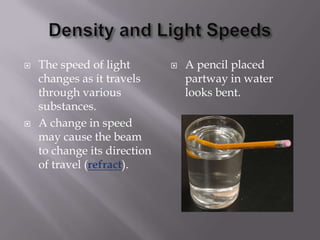Light refraction concepts
- 2. The topic of reflection and refraction lends itself to misconceptionsâĶ illustrations in textbooks are often not adequate to explain these concepts.
- 3. ïĻ The speed of light changes as it travels through various substances. ïĻ A change in speed may cause the beam to change its direction of travel (refract). ïĻ A pencil placed partway in water looks bent.
- 5. ïĻ Water is denser than airâ it has more matter in the same space. ïĻ Glass is denser than water. ïĻ When light enters a denser medium, it slows down. ïĻ When light enters a less dense medium it speeds up.
- 6. CONVEX CONCAVE ïĻ Cause light rays to converge (come together). ïĻ Cause light rays to diverge (spread out).
Editor's Notes
- Use the analogy of running through an empty room versus running though a room full of people. The extra âmatterâ would slow you down.
- People have learned to control light refractions with lensesâĶ







